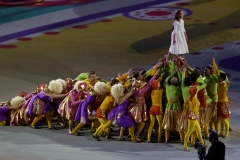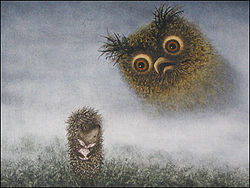This week, there was a post on Yahoo News comparing the Hunger Games movies and offering an explanation as to “why Catching Fire is superior to the first Hunger Games movie”— which is that it was shot in 35mm. with “old lenses!” (I have to add that I have been astonished at the degree to which it has become a meme that the second Hunger Games movie is infinitely superior; literally every adolescent that I’ve heard talk about the movies says this, and some then go on to describe the first movie as if it were shot by a detoxing wedding videographer with a Fisher-Price handycam.)
 Since issues concerning evolving platforms for image capture (both digital and celluloid-based) are addressed in Chapter 4 of Moving Images and a few of my mediateacher.net blog posts, I had to laugh when I read this article and thought, “It’s nice to see this much passion about cinematography in a Yahoo article!” At the same time, I remarked, “Hmmm, the writer needs a few lessons — after all, the first Hunger Games movie was shot in 35 as well!” This is why an understanding of Storytelling with Light from Moving Images can be so beneficial: One must look at all the decisions being made by director, cinematographer, and the lighting and art direction personnel on the movie that craft its look (and vfx too!). It’s how you create and work with the light and all of the things that it’s bouncing off of. In the meantime, I highly recommend checking out the clip from the Catching Fire Blu-Ray: it includes many interesting observations by cinematographer Jo Willems and director Francis Lawrence about visual communication, including selecting aspect ratio, working with film negative, devising approaches to shot selection through choice of lenses (such as the effect of using wider lenses on a project), and going “old school” in general.
Since issues concerning evolving platforms for image capture (both digital and celluloid-based) are addressed in Chapter 4 of Moving Images and a few of my mediateacher.net blog posts, I had to laugh when I read this article and thought, “It’s nice to see this much passion about cinematography in a Yahoo article!” At the same time, I remarked, “Hmmm, the writer needs a few lessons — after all, the first Hunger Games movie was shot in 35 as well!” This is why an understanding of Storytelling with Light from Moving Images can be so beneficial: One must look at all the decisions being made by director, cinematographer, and the lighting and art direction personnel on the movie that craft its look (and vfx too!). It’s how you create and work with the light and all of the things that it’s bouncing off of. In the meantime, I highly recommend checking out the clip from the Catching Fire Blu-Ray: it includes many interesting observations by cinematographer Jo Willems and director Francis Lawrence about visual communication, including selecting aspect ratio, working with film negative, devising approaches to shot selection through choice of lenses (such as the effect of using wider lenses on a project), and going “old school” in general.
 As an additional note, for those interested in the craft of acting, there was a superb piece on Hunger Games star Jennifer Lawrence by Manohla Dargis in this past Sunday’s New York Times, while for fans of Leonardo DiCaprio, a paired article by A.O. Scott was just as compelling. Both essays from the Times “Awards Season” series provide excellent discussion points for thoughtful debates about contemporary movies and American culture.
As an additional note, for those interested in the craft of acting, there was a superb piece on Hunger Games star Jennifer Lawrence by Manohla Dargis in this past Sunday’s New York Times, while for fans of Leonardo DiCaprio, a paired article by A.O. Scott was just as compelling. Both essays from the Times “Awards Season” series provide excellent discussion points for thoughtful debates about contemporary movies and American culture.







